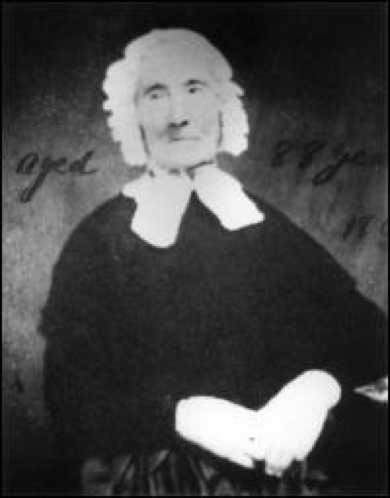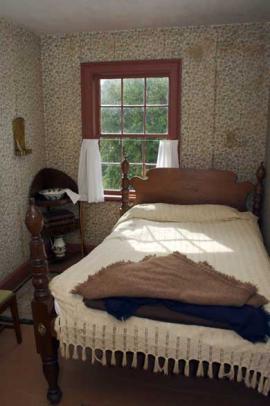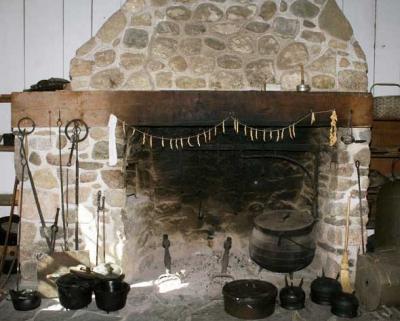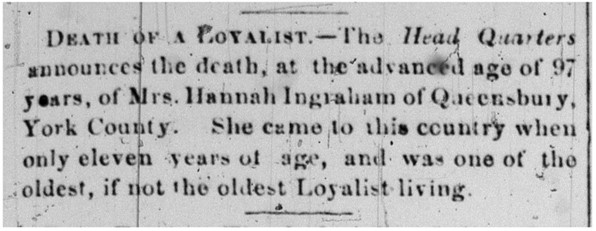Loyalist Lowdown: Hannah Ingraham, A Child’s Perspective

(Image courtesy of the Provincial Archives of New Brunswick, MC300-MS44-458)
Many existing primary sources for loyalists are from the point of view of men, especially well established men. These documents come in various form, such as letter books and court records. However, there is a narrative that still exists today that helps researchers and curious minds discover what life was like for a loyalist from the perspective of a young girl: Hannah Ingraham. Hannah was born in New Concord, New York in 1772 and died in Bear Island, Queensbury Parish, New Brunswick.
The recollections Hannah shared in her senior years contain extraordinary details about her life. These include: events before the war, during the war, her journey at the age of eleven to New Brunswick, her first Canadian winter, building the settlement in Fredericton, bartering to exchange goods in her community, and her relations with the French and Indigenous communities.
So, without further ado, here are ten tidbits in Hannah’s narrative about her amazing experience as a child loyalist refugee:
1. Her father was taken prisoner twice; the first time he escaped and took two months to find the army again. In her narrative, Hannah says: “Mother was four years without hearing of or from father, whether he was alive or dead; anyone would be hanged right up if they were caught bringing letters. Oh! Those were terrible times. At last there was talk of peace, and a neighbour got a letter from her husband, and one inside for mother, to tell her father was coming home.” One morning before the start of their journey, their house was surrounded by rebels who carried her father away to send him to prison for the second time: “When morning came, they said he was free to go.”
2. The family required navigational assistance from the French. The only “road” to get to Fredericton from Saint John was the river.
It was a sad sick time after we landed in Saint John. We had to live in tents; the government gave them to us, and rations too. It was just at the first snow then, and the melting snow and the rain would soak up into our beds as we lay. Mother got so chilled and developed rheumatism, and was never well afterwards.

Because of its presence so close to the hearth,
it was alleged that this was the warmest room of the house.
(Photo courtesy of Mike Meade, taken at the Ingraham House,
Kings Landing Historical Settlement)
3. In their early settlement years, Hannah’s family was the only one with a ‘house’ or something like it: “There was no floor laid, no windows, no chimney, no door, but we had a roof at least.” As a result, men would sometimes live with her family in the winters in exchange for their labour. Hannah also recalled that Fredericton was covered in raspberry bushes when she arrived here with her family. She said that, long ago, the Scots had settled in this area, but had been burned down by the ‘Indians.’
4. The winters were an adjustment; to get to school, Hannah had to wear snowshoes and haul her little brother John on a sled on her journey to school. Her little brother almost lost a toe (perhaps to frostbite) as a result of these treks to school.
5. Hannah’s family were the first to own a cow which they bought for 10 guineas from someone in Maugerville. Their neighbours, the Clements, were the second ones to get a cow, and out of envy someone in the town gashed the Clements’s cow. As Hannah described the culprit as an: “ill-tempered jealous man among us who owned just such a dirk.” As a result of this injury, Hannah’s father had to kill the cow. Hannah describes Mr. Clements and her father butchering the cow into portions of meat. Mr. Clements gave the Ingrahams a haunch of beef as pay for the aid in butchering. Hannah describes how difficult it was to cook such a large piece of meat with no oven; her family had to cook it in a dutch oven instead. (Dutch ovens are thick walled casserole dishes made out of cast iron which can be used to bake, boil, stew, and fry—and probably more. They just need fire to work!)

(Photo courtesy of Mike Meade, taken at Kings Landing Historical Settlement)
6.Hannah and her brother attended the first burial at the graveyard of the only church in town because they heard the drums beat while they were picking berries and quickly went to see what the commotion was about.
7. Parson Samuel Cooke, the minister, came over to their house to baptize Hannah’s little brother Ira and then stayed for dinner.
8. Hannah’s childhood perspective of the relations between British Settlers and the Indigenous community is interesting. She remembers seeing forty canoes in the river at one time, and how Peter Fraser, a local fur trader, would cheat the Indigenous people as “he would put his fist on the scale and say it weighed a pound.”
9. One day, when Hannah was home alone with the baby, likely little Ira, an “Indian” came to her door to sell furs; afraid, she responded by asking him if he had “small-pox.” Hannah recalls that “they were afraid of smallpox for Indians mostly die if they get it.”
10. The St John River would sometimes be high—especially in the spring. For example, in May 1795, when Samuel Cooke and his son came to town to attend a funeral, they drowned crossing the river, “The next day someone saw a straw hat floating, his son’s hat, and then the canoe bottom up […] it was a week before they found the bodies floating down the river.”
Today, you can visit Hannah’s house at Kings Landing Historical Settlement in Prince William, New Brunswick. This is the home where she lived with her little brother Ira and his family, as she never married. Hannah died when she was 97 years old. You can read her full narrative in the Loyalist Collection at the Harriet Irving Library in a print version, or online as part of the Atlantic Canada Portal.

(UNB Libraries Microform Newspaper Collection)
Loyalist Day is celebrated in the province of New Brunswick on May 18th. Look for other post on New Brunswick loyalists this month!
Annabelle Babineau is a student assistant at the Harriet Irving Library. She is currently completing her Bachelor of Arts in the English Honours Programme.
SUBJECTS: Hannah Ingraham, trade, indigenous peoples, New York, French, children, narrative, loyalist, New Brunswick, migration, refugees



Comments
Keke (not verified)
Sun, 12/02/2018 - 12:11
Permalink
Hannah Ingraham
i like your website and all the information about her. This was a great help.
Vanessa w (not verified)
Tue, 12/04/2018 - 14:31
Permalink
hannah ingraham
This was a great websitethanks for the great facts and you should be very proud.
Gary Ingraham (not verified)
Wed, 01/15/2020 - 12:59
Permalink
Related
I'm related to Hannah, but I cannot figure out from which of her brother's descendants I come from.
Gary Ingraham
lgrandy
Wed, 01/15/2020 - 13:37
Permalink
Ingraham ancestor
Hello! It's always great to hear from a loyalist descendant. If you have not visited the Provincial Archives of New Brunswick in person or online, I would suggest that would be your first step to tracing your New Brunswick ancestry. They are the experts in that area and they have many useful records online: https://archives.gnb.ca/Archives/?culture=en-CA. If you would like to do research within The Loyalist Collection, you can send us a message at mic@unb.ca.
sabrina (not verified)
Fri, 01/29/2021 - 13:09
Permalink
wow
this taught me so much thank you Hannah was a true survivor
Add new comment